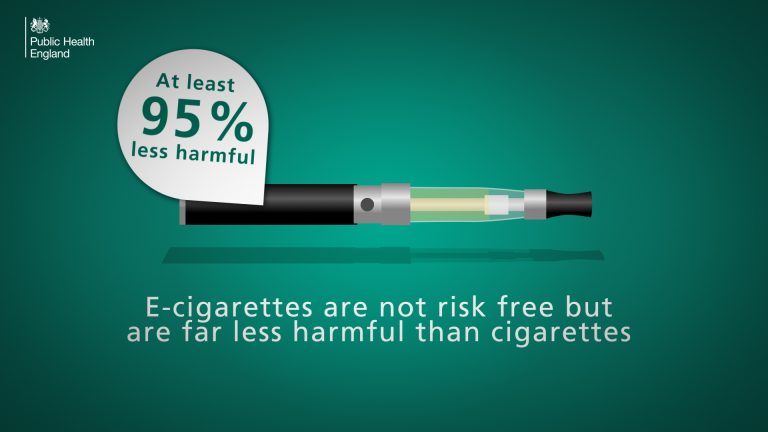In the UK, governments support many smoking cessation methods, including e-cigarettes. The aim is to reduce smoking in a short time. And vejpning plays a key role.
Quitting smoking is an arduous journey. Most smokers want to, but statistics show that most people try to quit without help, ends with relapse.
In the UK, the authorities are therefore fully committed to supporting all methods of smoking cessation, including e-cigarettes. Public Health England wants to reduce smoking from the current 15 per cent to below 5 per cent by 2030, and electronic cigarettes are an important part of that, according to the Department of Health.
It is not entirely uncontroversial. E-cigarettes are a relatively new technology that has only been on the market for just over 10 years. And the health effects of long-term use are not fully known.
"When e-cigarettes appeared on the market 10 years ago, we became very interested in how the technology could be used."
This is according to John Newton, Head of Health Promotion at the UK Department of Health.
'At first, of course, many people were hesitant. But we collected data. And it turned out that e-cigarettes were successfully used by smokers to quit smoking," he said. CNBC television channel.
"Pretty soon it became clear that e-cigarettes had few measurable, harmful, health effects compared to regular cigarettes. They are not completely risk-free, but for a smoker, the electronic cigarette poses significantly lower health risks," says Mr Perez. John Newton.
Public Health of England has compiled and analysed an extensive body of research on e-cigarettes since 2015. At a global level. The document is a live report which is updated annually, as new data is published. Currently, the report summarises over 2000 studies, with up to 500 new ones added each year. The report "E-cigarettes - an evidence update" is a benchmark for political decisions and health promotion policies in the country. It is also the basis for information for doctors, midwives, social workers and other organisations working in the field of health and wellness. The message is that e-cigarettes are 95 per cent safer to use, compared to cigarettes.

"We wanted to make it clear that vejphing is far less harmful than smoking. Tobacco smoke contains tar, carbon monoxide and thousands of other toxic substances that cause cancer, cardiovascular disease and nerve damage; it is among the absolute worst things you can do to your body. Reducing the risk of injury by 95 per cent is a matter of life and death." Says John Newton.
The authority has been criticised for its clear position. A recurring argument is that knowledge about e-cigarettes is currently weak. But John Newton does not agree with this.
"The vapour from an e-cigarette contains very few of the harmful substances in the smoke. It has similar values to someone using classic nicotine medicines. It is of course impossible to put an exact figure on health and safety, but when we say '95 per cent safer', it is as close as we can get. Above all, the message is clear." says John Newton.
In 2019 and 2020, the authorities, together with other government-supported non-profit organisations, have launched several campaigns on the benefits of e-cigarettes for smoking cessation. The Swedish Public Health Agency continuously highlights research to encourage smokers to switch to e-cigs.
Today (2019), nearly 2.5 million people use e-cigarettes regularly in the UK. Public Health England notes that there are two groups that vejpar: those who use e-cigarettes to cut down on smoking and those who have quit smoking altogether.
In summer 2019, vejpshoppes also opened in two of the country's hospitals. At the same time, smoking was completely banned on hospital premises. The aim was clear: to encourage smokers to switch to e-cigarettes or nicotine medicines - or not to smoke at all.

A question that has raised debate is the use of e-cigarettes among young people. Alarmist reports from different countries suggest that use has 'exploded' and that young people are falling into a nicotine addiction that they would not otherwise have done if not for e-cigarettes. In England, however, research by Public Health England suggests something completely different.
"I think what causes confusion and disagreement among researchers is that they look at too many different types of phenomena. Young people will inevitably try new things and if you only look at those who ever tested an e-cig, the numbers are obviously very high. However, if you look at regular use and how many people use them, for example, every week. Then we see a completely different pattern," says John Newton.
He wants to minimise concerns that e-cigarettes would lead to a new generation of smokers. Rather, the research shows a different trend: that vejping is slowly replacing smoking among young people.
"Four per cent of young people use e-cigarettes fairly regularly. The majority of these are already smokers or ex-smokers. We also know that the proportion of never smokers who now use e-cigarettes is minimal, less than one per cent. These are fairly static figures, they look the same over time," says Mr Newton.

In many countries e-cigarettes and vejping are still viewed with suspicion by both politicians and health organisations.
The situation in the UK is different. As well as broad political support through the Department of Health, organisations such as Cancer Reasearch UK, Actions on smoking and health (ASH) and British Heart Foundation active in providing information and research on e-cigarettes. The basic attitude is that alternative forms of nicotine delivery are an effective method of quitting smoking and that vejpning has an obvious place to fill for some smokers.
"Vaping has proven to be the most popular method. And the research we do shows that e-cigarettes, preferably in combination with counselling, work better than traditional nicotine medicines" says Linda Bauld, Professor of Public Health Sciences at the University of Edinburgh, to BBC's Breifing Room (a podcast on vejpning and health risks)
Behind the reasoning is a philosophy in the health sciences, "harm reduction", or "Harm reduction"which is the international concept. Harm reduction as a method has long been discussed in public health research, particularly in the treatment of heavy drug addiction.
The principle is that the user does not change his or her behaviour, but instead reduces the risks and harm caused by the behaviour.
Distribution of clean syringes to drug users and methadone programmes are some examples of successful harm reduction.
For smokers, it is about alternative ways of using nicotine: nicotine patches, nicotine gum, and indeed snus, are harm reduction in action. Not surprisingly, the UK is a world leader in this approach.
"We are very clear about our views on nicotine. Nicotine is a stimulant, it is an addictive substance, but it does not cause cancer and it is not a direct cause of heart disease. We have been offering nicotine for smoking cessation for a long time, including to pregnant smokers, which is not done in other countries. Often, the risks of nicotine are linked to the addiction itself and health risks are seen that science simply does not confirm," says Mr Perez. Linda Bauld.
According to Linda Bauld nicotine is persistently labelled as harmful precisely because of smoking and its widespread harmful effects.
"Smoking is so harmful that nicotine is often confused with the properties of smoke. This is also the case in the UK. The general perception is that nicotine is very harmful and that it causes cancer, even though the research clearly shows that this is not the case. Our authorities are working hard to roll out e-cigarettes and make them available to smokers who are unable or unwilling to quit by other means. At the same time, we have strict legislation, through the European Tobacco Products Directive (TPD), to prevent non-smokers and young people from using them. But it is a balancing act where several health interests have to be taken into account." says Linda Bauld.
The number of smokers has fallen rapidly in the UK. Local stop-smoking centres and government information campaigns are clearly a reason for this, according to Linda Bauld.
Together with a encouraging attitude to e-cigarettes.
"We have an evidence-based policy on harm reduction. It gets some criticism, but I think it's important to stay the course. It works, you see. Smoking is declining rapidly. Smoking among young people is at an all-time low. This is because we have invested in research on the behaviour of smokers in the market and met their needs. Moving towards a smoke-free society", says Linda Bauld to the BBC.





Very good and accurate facts